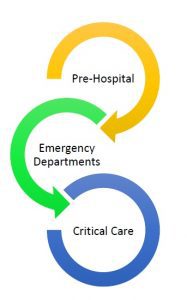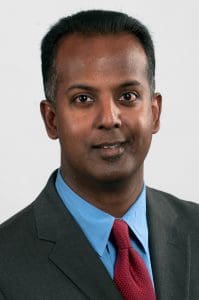Emergency Care Providers Urge Education, Training, Technology
| Feb. 21, 2017 | There are inconsistencies in the quality of emergency care across Arkansas that can and should be addressed, and UAMS staff are partnering with stakeholders to get that message out to lawmakers and the public.
In short, they are asking lawmakers to improve education, training and technology for emergency, or acute, care providers. They are asking the public to let their representatives know that this is a topic of upmost importance.
“It shouldn’t take personal experience with a car accident or other critical care incident to get this on peoples’ radars, it should be there already, but unfortunately, it isn’t,” said Rawle A. “Tony” Seupaul, M.D., chair of the Department of Emergency Medicine in the UAMS College of Medicine and the Stanley E. Reed professor for Emergency Medicine, Trauma and Injury Prevention.
Seupaul said step one is awareness.
“We need communication, support and consistency throughout acute care. I really think this is under-recognized,” Seupaul said. “For example, the state of Arkansas has less than 200 board-certified emergency medicine physicians. Outside of northwest or central Arkansas, you’re unlikely to see an emergency care doctor.
 “Another example is the lack of coordinated care in the pre-hospital setting. Some places are great at it, and in other places, it’s extremely variable. And the truth is, that has been shown to have a great impact on the level of care and on outcomes.”
“Another example is the lack of coordinated care in the pre-hospital setting. Some places are great at it, and in other places, it’s extremely variable. And the truth is, that has been shown to have a great impact on the level of care and on outcomes.”
Step two is for the public and lawmakers to commit to addressing the challenges faced by emergency care.
“This needs to be part of the discussion as changes are made to our health care system,” Seupaul said. “We need t o decide what we need in this state and the public should communicate that to their legislators and let them know that it is important.”
Seupaul is the lead author on a white paper reporting the findings from the July 2015 Improving Critical & Acute Care Through Regional Education (ICARE) conference in Rogers. The three-page document aims to quickly summarize the area’s greatest needs, as identified by the full spectrum of acute care represented at the meeting: paramedics, law enforcement, students, faculty, residents, nurses, pharmacists, respiratory therapists, firefighters, industry, legislators and state officials like the surgeon general and employees from the Arkansas Department of Health.
The paper explains that there is currently a three-pronged system in acute care: pre-hospital (EMS, fire and first responders), emergency departments and critical care (trauma care, acute care surgery, and medical critical care). Gaps exist between these three groups in terms of coordination and communication, and the ICARE group calls upon legislators to help them address those gaps.
Pre-hospital:
- Improve education and training, including statewide standardization of requirements and accreditation standards
- Improve communication and coordination with emergency departments to ensure patients are taken to a hospital equipped to deal with their particular injuries using the proper form of transportation, such as by ambulance or helicopter.
- Create a statewide director position to coordinate pre-hospital care
Emergency departments:
- Increase use of telemedicine to reduce costly patient transfers and improve care
- Standardize a method of sharing patient information regionwide
- Increase insurance coverage of primary care to reduce the number of non-emergency visits to the ER
Critical care:
- Improve funding for the education of medical professionals
- Educate the public on the kind of critical medical decisions they can make to prevent needing the emergency room
- Integrate standard medical technology systems across the state
- Train health care professionals statewide in best practice protocols for critical care
Miranda Morris was director of education and quality initiatives and assistant director of continuing education at UAMS at the time of the conference. She developed the tool used by participants to identify issues and goals that became the basis for the white paper. She is now chief operational officer of the Arkansas Center for Health Improvement.
 “I really feel that ICARE is especially meaningful because the goal is to engage with the community and make a real impact on policy, through things like the white paper,” Morris said. “It’s rare you have such an amazing group of really smart people all in one place, so it was awesome to see what ideas they could come up with about making a difference.”
“I really feel that ICARE is especially meaningful because the goal is to engage with the community and make a real impact on policy, through things like the white paper,” Morris said. “It’s rare you have such an amazing group of really smart people all in one place, so it was awesome to see what ideas they could come up with about making a difference.”
Additional contributing authors on the white paper are: Danny Bercher, Ph.D.; Mike Anders, Ph.D.; Cathy Buzbee; Muhammad Jaffar, M.D.; Wendy McCloud; Heather Moseby, R.N. — all from UAMS — and Jamin Snar; Greg Brown; Bill Mason, M.D.; and Tom Jenkins
The ICARE conference is held on an annual basis. The next meeting is May 3-5 at the Chancellor Hotel in Fayetteville (http://icareconference.com/). Its goal is to identify gaps in acute care and provide participants with the latest information in acute care. White papers and legislative efforts are not always a result of the meeting, but the 2015 group felt that reaching out to lawmakers and the public is key to finding solutions.
“We want to make sure we get broad-based participation again this year,” Seupaul said. “We really think we’re on to something that will create positive change for health care in Arkansas.”

